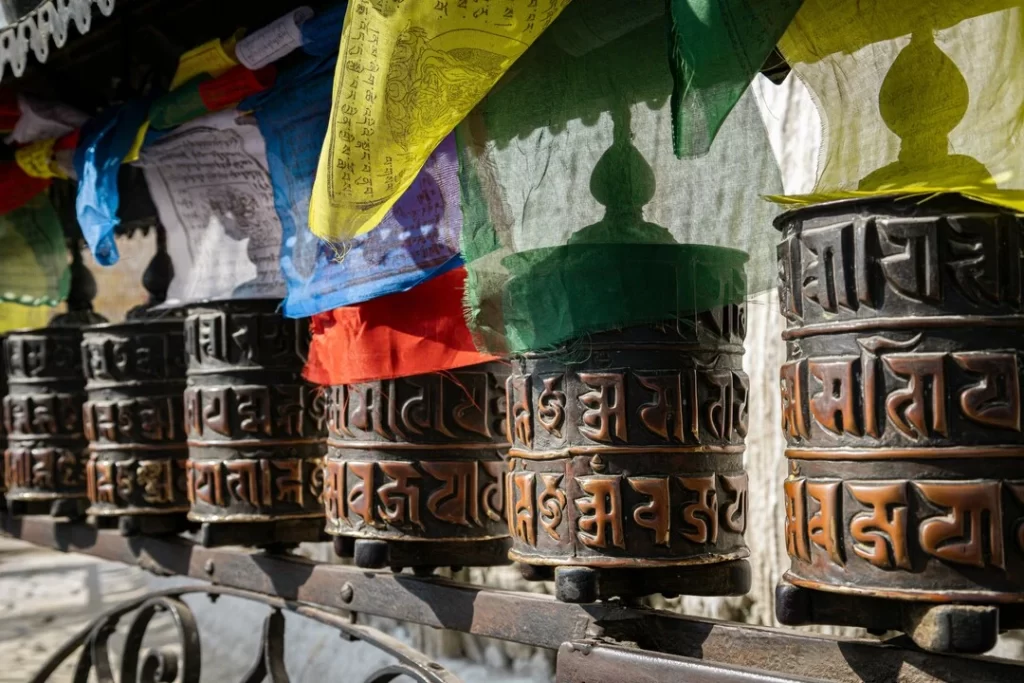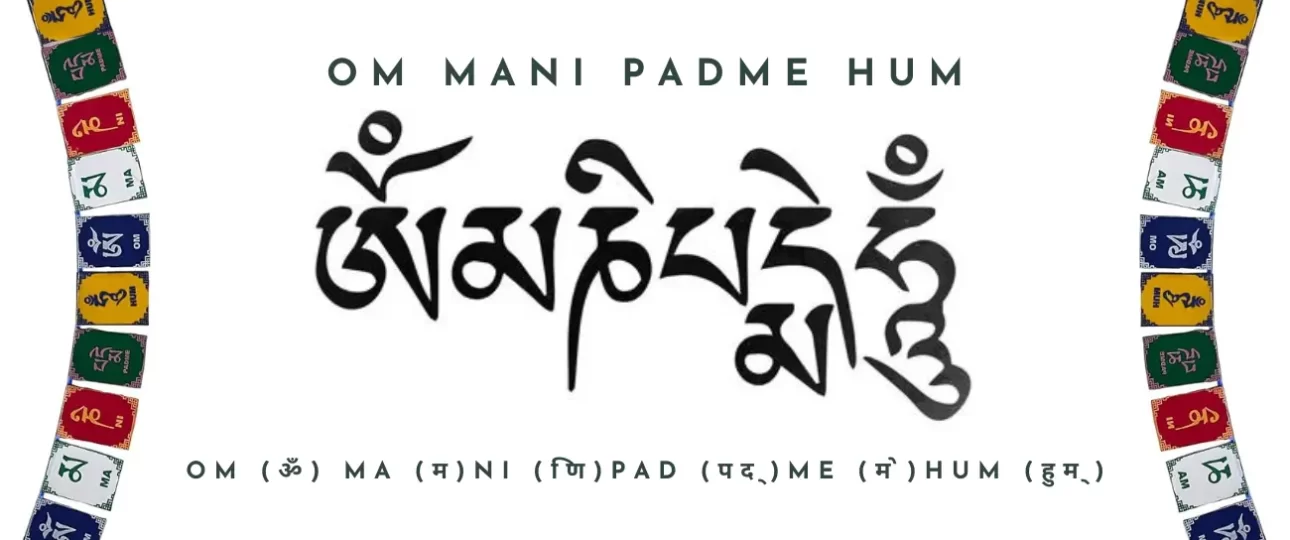What is Om Mani Padme Hum meaning?
“Om Mani Padme Hum” is a revered and powerful mantra in Tibetan Buddhism, often seen inscribed on prayer wheels, flags, and stones. This six-syllable mantra is more than just a collection of words; it carries profound spiritual significance and is believed to embody the essence of the Buddha’s teachings. Let’s delve into the meaning, origin, and significance of “Om Mani Padme Hum.”
The mantra “Om Mani Padme Hum” is associated with Avalokiteshvara (Chenrezig in Tibetan), the Bodhisattva of Compassion. According to Buddhist tradition, Avalokiteshvara made a vow to assist all sentient beings in achieving enlightenment and is considered an embodiment of compassion.
The mantra first appeared in the Karandavyuha Sutra, a Mahayana Buddhist text dating back to the early centuries CE. Over time, it has become one of the most widely used mantras in Tibetan Buddhism.
Breaking Down of the Mantra “Om Mani Padme Hum”
The six syllables of the mantra, each carry a unique meaning and significance:
Om (ॐ):
Sound: The sacred syllable.
Symbolism: Represents the universe and the divine energy that permeates everything. It is often interpreted as the essence of the enlightened form.
Ma (म):
Meaning: Removes jealousy and establishes ethics.
Symbolism: Represents the practice of compassion and the purification of the body.
Ni (णि):
Meaning: Removes desire and establishes patience.
Symbolism: Stands for the practice of devotion and the purification of speech.
Pad (पद्):
Meaning: Removes ignorance and establishes perseverance.
Symbolism: Symbolizes the cultivation of wisdom and the purification of the mind.
Me (मे):
Meaning: Removes greed and establishes concentration.
Symbolism: Represents the practice of morality and the purification of inner desires.
Hum (हुम्):
Meaning: Removes hatred and establishes wisdom.
Symbolism: Signifies the unity of method and wisdom and the purification of all aspects of one’s being.

The Complete Meaning of “Om Mani Padme Hum”
When combined, “Om Mani Padme Hum” can be loosely translated to “Hail to the Jewel in the Lotus.” This phrase encapsulates the core Buddhist belief in the potential for all sentient beings to achieve enlightenment. The “jewel” represents the enlightened mind of a Buddha, while the “lotus” symbolizes the purity and beauty that can arise from the muddy waters of samsara (the cycle of existence).
The Spiritual and Practical Significance
Reciting the mantra is believed to purify the mind, body, and speech, transforming negative emotions and karma into positive spiritual qualities.
The mantra invokes the blessings of Avalokiteshvara, fostering compassion towards all beings and helping practitioners develop a compassionate mindset.
Also, it is considered a protective chant that wards off negative energies and influences, offering spiritual safeguarding to those who recite it.
Furthermore, chanting the mantra aids in focusing the mind, making it a powerful tool for meditation and mindfulness practice.
Repeating the mantra is said to accumulate merit and wisdom, which are essential for progressing on the path to enlightenment.
Cultural Expressions
In Tibetan culture, “Om Mani Padme Hum” is not just a personal mantra but a communal practice. You’ll find it:
Inscribed on Prayer Wheels: Spinning these wheels is believed to release the mantra’s blessings into the world.
On Prayer Flags: As the wind blows, the prayers and mantras are carried across the land.
Carved on Stones: Known as Mani stones, these carvings are often placed along pilgrimage routes and roadsides.
Even in contemporary times, the mantra holds significant relevance. It is a source of comfort, spiritual connection, and inspiration for millions around the world. Many people incorporate the mantra into their daily lives, using it as a tool for maintaining mental peace and emotional balance amidst the stresses of modern life.

How to Practice “Om Mani Padme Hum?”
Begin by finding a quiet place. Sit comfortably, close your eyes, and take a few deep breaths. Slowly start chanting “Om Mani Padme Hum,” either silently or aloud. Focus on the sound and the intention behind each syllable.
While chanting, visualize a radiant white light filling your body, emanating compassion and purity. Imagine this light spreading outwards, bringing peace and happiness to all beings.
Try to carry the essence of the mantra into your daily activities. Practice mindfulness, compassion, and kindness in all your interactions.
What happens when you chant Om Mani Padme Hum?
Chanting “Om Mani Padme Hum” has profound spiritual effects that deeply resonate with practitioners. It is believed to purify the mind, speech, and body, removing negative thoughts, harmful speech, and unethical actions.
This purification process aligns the practitioner with the principles of compassion and wisdom, fostering a compassionate mindset that mirrors the qualities of Avalokiteshvara, the Bodhisattva of Compassion.
Additionally, the mantra is thought to accumulate spiritual merit, essential for progressing on the path to enlightenment and ensuring favorable conditions in both this life and future rebirths.
Chanting “Om Mani Padme Hum” also acts as a protective shield, warding off negative energies and obstacles, thereby offering spiritual safeguarding.
Overall, the mantra serves as a powerful tool for spiritual transformation, helping individuals cultivate a deeper sense of compassion, wisdom, and spiritual protection.

Conclusion
“Om Mani Padme Hum” is much more than a collection of syllables; it is a profound expression of compassion, wisdom, and the aspiration for enlightenment. Whether you are a seasoned practitioner or a curious newcomer, this mantra offers a pathway to inner peace and spiritual growth. Embrace it, and let its timeless wisdom guide you on your journey.
FAQs about Chanting “Om Mani Padme Hum”
1. What does “Om Mani Padme Hum” mean?
“Om Mani Padme Hum” is a six-syllable mantra in Tibetan Buddhism that translates to “Hail to the Jewel in the Lotus.” Each syllable has a specific meaning and purpose, collectively embodying the essence of compassion and the potential for enlightenment.
2. Who is Avalokiteshvara?
Avalokiteshvara, also known as Chenrezig in Tibetan, is the Bodhisattva of Compassion. This enlightened being made a vow to assist all sentient beings in achieving enlightenment and is often associated with the mantra “Om Mani Padme Hum.”
3. How should I chant “Om Mani Padme Hum”?
Find a quiet and comfortable space, set a clear intention, sit with a straight spine, and take a few deep breaths. Begin chanting the mantra slowly and deliberately, either aloud or silently in your mind. Visualize a radiant light emanating from your heart or from an image of Avalokiteshvara, spreading peace and healing.
4. What are the benefits of chanting this mantra?
Chanting “Om Mani Padme Hum” offers spiritual, psychological, and physical benefits. It purifies the mind, speech, and body, fosters compassion, provides protection, enhances mental clarity and emotional balance, reduces stress, and improves respiratory and heart health.
5. How often should I chant the mantra?
There is no set frequency for chanting “Om Mani Padme Hum.” You can start with a few minutes daily and gradually extend the duration as you become more comfortable with the practice. Regular, consistent practice is more beneficial than infrequent, prolonged sessions.
6. Can I chant “Om Mani Padme Hum” silently?
Yes, you can chant the mantra silently in your mind. The effects of the mantra can be felt whether it is chanted aloud or silently, as the focus and intention behind the practice are what matter most.
7. Is it necessary to be a Buddhist to chant this mantra?
No, you do not need to be a Buddhist to chant “Om Mani Padme Hum.” The mantra is universal and can be practiced by anyone seeking its spiritual and psychological benefits.
8. Can I use a mala while chanting “Om Mani Padme Hum”?
Yes, using a mala (a string of prayer beads) is a common practice in chanting. A mala typically has 108 beads, and counting the beads can help you focus and keep track of the repetitions of the mantra.
9. What should I visualize while chanting the mantra?
While chanting, you can visualize a radiant white light emanating from your heart or an image of Avalokiteshvara. Imagine this light spreading throughout your body and into the world, bringing peace, compassion, and healing.
10. What should I do if my mind wanders while chanting?
It is natural for the mind to wander. When you notice your mind drifting, gently bring your focus back to the sound and meaning of the mantra. Over time, with consistent practice, maintaining focus will become easier.




1 Comment
Very illuminating explanation